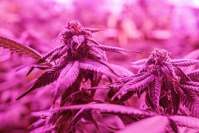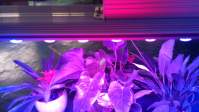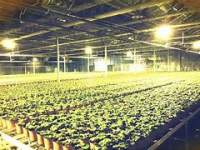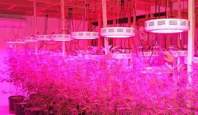Six ways to supplement the light of greenhouse vegetable LED plant lights in winter
In the process of growing vegetables in greenhouses in winter, due to the lack of lighting in the sheds, if no supplementary light measures are taken, not only will the vegetables not achieve the effect of increasing production, but it will even affect the quality of the vegetables and prolong the growth cycle of the vegetables. Eventually, it will lose the significance of growing vegetables in greenhouses in winter. LED plant growth lamp is a kind of lamp that simulates sunlight on photosynthesis of plants. It can supplement the light of greenhouse vegetables or even completely replace sunlight. It can increase the yield of vegetables and improve the quality of vegetables.
Greenhouse vegetable plant light
1.Reasonable collocation. When planting vegetables of different varieties and heights in the greenhouse, consider the direction of the sun's rays in the northern hemisphere, and follow the principle of north-high and south-low in a reasonable combination. When transplanting, the cotyledons are arranged in parallel, and the cultivation specifications are strictly enforced. , The plant and row spacing are coordinated to make the plants grow neatly. Try to reduce the shading LED plant growth lights between plants.
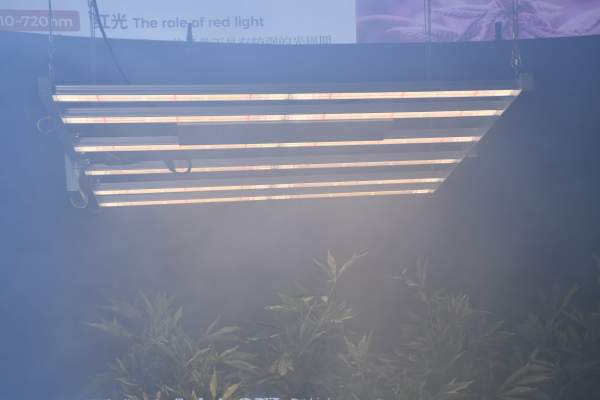
2. Change the method of scaffolding. When cultivating cucumbers and kidney beans and other racking vegetables in a greenhouse, waste film can be used as a hanging rack to replace the racking, which can effectively improve the utilization rate of light. The method is to fix a wire along the upper part of the arch, insert a 25 cm long bamboo stick at the root of cucumber and bean, and then cut the old film into strips and tie it vertically to the bamboo stick and wire, when the cucumber and bean are stretched out. After the vine, coil the vine on the strip of the old film, and then coil it every 5 to 7 days. If you need to set up a rack, use the approach of tilting the front row to the south, the middle row upright, and the rear row tilting to the north, which can increase the light utilization rate to about 10%.
3. Keep the shed film clean. According to the survey, a layer of water droplets attached to the shed film can reduce the light transmittance to 30%-50%; after the new film is used for 2, 10, and 15 days, the light in the shed can be reduced to 14% due to dust contamination. , 25% and 28%. You should insist on cleaning the surface of the shed. You can tie a soft cloth strip to a wooden pole every morning after the grass curtain is uncovered in the greenhouse, and clean the dust and debris on the plastic film shed from top to bottom, so as to increase the light. To more than 30%, but you have to insist. To reduce the water droplets on the shed film, you can use the mulch film in the shed; change the irrigation method, use the under-mulch irrigation method and hose for drip irrigation; clean the water droplets on the shed film with a clean rag in the morning; immediately release the air to reduce humidity after irrigation And so on, have very good results. In addition, after snowing, the snow on the shed film should be cleared in time to increase transparency and light intake.
4. Uncover the curtains at the right time Properly uncover the curtains early and delay the curtains, which can prolong the sunshine time of the greenhouse. The curtains are usually uncovered 0.5 hour to 1 hour after the sun comes out. The curtain time is best half an hour before the sun sets, not too late. The curtain should also be uncovered on a cloudy day, striving for the scattered light to shine. The curtains are generally not opened when it snows, and will be opened when the weather turns clear.
5. Utilize the reflective curtain Use the aluminum-plated reflective curtain of 3 meters long and 2 meters wide, hung on the upper end of the rear column of the plastic greenhouse, and the lower edge hangs down to the ground. This can increase the brightness of the ground to about 20%, and to a certain extent can increase the temperate ground temperature of the shed, which is conducive to the healthy growth of vegetables and improves the yield and quality. In addition, laying a silver gray film on the ground can also increase the light intensity between plants.
6. Choose energy-saving LED plant growth light from Yaorong Technology. The LED plant growth light can emit red light with a fixed wavelength of 610nm-720nm and blue light with a wavelength of 400nm-520nm. Among them, the red light with a wavelength of 610nm-720nm can be chlorophyll. Absorbing 75%-85%, the red light of this wavelength has a significant impact on the germination, flowering and fruiting of plants (seeds), the synthesis of plant chlorophyll, and photosynthesis and photoperiod effects. The wavelength of blue light is 400nm-520nm. Chlorophyll can absorb more than 90%. It is a strong band for plant growth and photosynthesis. The absorption ratio of chlorophyll and carotenoids is the largest. It can promote the development of crop roots and reduce growth points. The stem becomes thicker; it makes the crop strong and the ability to resist disease is obviously enhanced.
The key to the success of greenhouse vegetable cultivation in winter is to supplement the light. As long as the supplement of light is done well, other aspects will come naturally, and there will be a big harvest.


